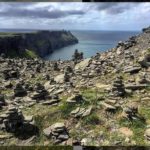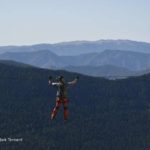The Ecrins are roughly bounded by the towns of Grenoble, Briancon and Gap in the Hautes-Alpes region. The Ecrins National Park, created in 1973, retain a wild splendour with peaks of over 4000m and remote valleys. Ailfroide is one of the bases to explore the Ecrins with the village of Vallouise a short distance down the valley. Ailfroide is situated in an idyllic location, flat, well almost, pastures surrounded by larch trees cut through with tumbling glacial streams. It’s a paradise for walkers whilst mountaineers and rock climbers can start their climbs within a few hundred metres of the centre. For the walker there’s plenty of choice.
For those wanting a multi-day tour there’s the Tour of the Ecrins, the GR54 one of the most challenging after Corsica’s GR20. We took in some sections of the Tour of the Ecrins and explored the area around Vallouise and Ailfroide.
Arriving from the Maurienne valley in Savoie via the Col de Telegraphe, the Col de Galibier and Briancon we arrived in Ailfroide in the late morning and were keen to stretch our legs. We set off up the direction Claphouse valley in the direction of the Pelvoux and Sele refuges. It was lovely walking through the larch forest alongside a wild mountain stream showing evidence of the high water levels of the spring snow-melt. As we cleared the forest it was great to see some chamois on the other side of the river. Even more surprising as we reached our turning point was to see a chamois a few metres from the path.
The following day we left the village of Vallouise and drove up to the valley de Chambran. Dew covered the grass as we put our boots on. After a pleasant walk up the gently rising valley bottom we started to climb more steeply up a zig-zag path before cresting the lip of the glacial cirque. In front of us the turquoise watered lake of the Lac de l’Eychauda. Large areas of snow (neves) came right down to the lake on the far side. A short walk further took me up to the col des Grangettes from which I could see down to Monetier-les-Bains and further towards the Queyras. The tour of the Ecrins, at least the ?normal? route passes via the Col de l’Eychauda before arriving at Chambran but it would be perfectly feasible to make a variation passing by the Col des Grangettes in order to take in the lake.
The Col de l’Aup Martin (2700m) is considered to be one of the more challenging cols on the GR54. A short drive up the narrow twisting road from Vallouise brought us to Entres-les-Aigues. Two paths left from the parking area, one making for the refuge des Bans, and the other heading for our objective. A wooden footbridge about 70m long took us across a large rocky river bed with just a relatively small stream in the centre. One could imagine the volume of water that must flow here in the spring. Passing through more larch forest we entered a narrow valley, steep rocky slopes dropping away into the river bed. Huge areas of debris covered snow covered the stream in places with gaping, dripping holes where the snow had finally collapsed. Clearly an area with a big avalanche potential in winter.
The valley opened out with views expanding. The smell of sheep announced our arrival by the shepherd’s cabin of Jas-Lacroix with a small annex for walkers. The shepherd’s washing hung outside but there was no sign of the shepherd himself. Crossing a stream the path started to gain height more steadily before arriving on a grassy plateau with an enormous herd of sheep. We saw the shepherd coming down towards us with two border-collies at heel. We stopped to chat with the young shepherd who turned out to be a keen mountaineer and we ended up chatting about Scotland and Ben Nevis.
The path became much rockier and zig-zagged through broken ground before a traverse across a stream filled gully took us on to the first schist covered slope. I went on alone, traversing a steep schist covered slope set at around 35-40 degrees (I measured the angle with my ski poles). I reached a small rocky barrier first crossing below it and then back above. Another two changes of direction and I was on the col. A few hundred metres away was the Pas de la Cavale, another col, that precedes the descent to the refuge Pre-de-la-Chaumette.
Talking to the owner of the gite in Vallouise the following morning we heard that several tour operator groups had people drop out on this stage. She also said that the leaders complained of the groups they were asked to take were too large, up to 14, and the operator downgrading the difficulty of the tour to attract more customers. Interesting.
One of the Ecrins most famous peaks is the Barre des Ecrins (4102 m) and the normal approach is from the wondefully name Pre de Madame-Carle. A large stony path led us to a bridge and then a well-trodden path zig-zagged up the mountain-side. A marmotte appeared on the path and came towards us. I bent down and it came right up and put its paw on my hand ? amazing! Out with the camera to get some more marmotte shots for my growing collection. I imagine that this particular marmotte has been fed by people, which can lead to illnesses for marmottes, so please avoid the temptation.
Higher we crossed over the stream coming from the glaciers snout and climbed up rock and a bouldery path to reach a shallow ?lake? with gorgeous reflections of Mont Pelvoux. A final steep rocky section took us to the Refuge du Glacier Blanc (2450m) to enjoy a drink on the terrace with the company of the ?Choucas? (Alpine Choughs).


